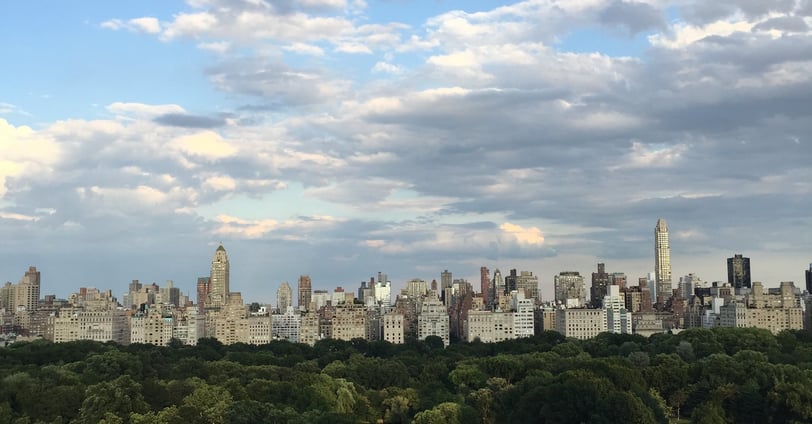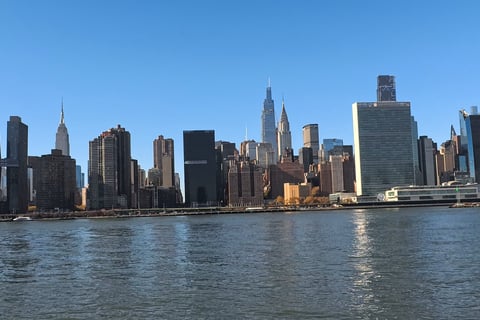How to Find the Best Hotel in NYC A Local’s Guide for Every Budget
Discover where to stay in NYC with this local guide to the best hotels for every budget. Find insider tips on neighborhoods, seasonal deals, and how to book the perfect NYC hotel in 2025
Daniel Alvarez


Welcome to New York City! I’ve lived here for years, and if there’s one question I get asked all the time, it’s: “Where should I stay in NYC?” Trust me, it’s a great question because finding the perfect hotel in New York can feel like an adventure of its own. With so many neighborhoods, price ranges, and types of accommodations, it can get overwhelmingly fast.
The good news? You’re in the right place. In this guide, I’ll give you the inside scoop on where to stay, how to find the best deals, and what to expect based on your travel style and budget. Whether you’re looking for a luxury escape or a budget-friendly spot, there’s a perfect hotel waiting for you in NYC. Let’s dive in!
Top Neighborhoods to Stay in NYC
Each neighborhood in New York has its personality. Some are buzzing with life 24/7, while others offer a more laid-back, local vibe. Here’s a detailed guide to the best areas to stay, with my honest take on each:
1. Midtown Manhattan – Tourist Central
Best for: First-time visitors, theater lovers, and luxury travelers.
Midtown is the heart of Manhattan, packed with landmarks like Times Square, the Empire State Building, and Grand Central Terminal. If you want to be close to all the action and don’t mind the hustle and bustle, this is the perfect area for you. Expect higher prices, but the convenience makes it worth it.
But even with the higher prices in this area, you can find a good rate if you plan or use some tools to get the best hotel rates.
Hotel Examples:
Luxury: The Langham – Spacious rooms and personalized service near Fifth Avenue.
Mid-Range: Moxy Times Square – Trendy, fun vibe with a rooftop bar.
Budget: Pod Times Square – Compact rooms with smart designs at a reasonable price.
2. Lower Manhattan (Soho, Tribeca, Financial District) – Historic Meets Hip
Best for: Boutique hotel lovers, couples, foodies, history buffs
Lower Manhattan is a great mix of old and new. Tribeca and Soho are known for their cobblestone streets, luxury boutiques, and stylish hotels. Meanwhile, the Financial District offers a more corporate feel but has recently become a trendy spot for visitors.
Hotel Examples:
Luxury: The Greenwich Hotel – Rustic-chic and owned by Robert De Niro.
Mid-Range: Arlo Soho – Modern, minimalist rooms with great common spaces.
Budget: The Wall Street Inn – Affordable and close to Battery Park.
3. Upper West Side – Family-Friendly and Laid-Back
Best for: Families, museum lovers, nature enthusiasts
The Upper West Side is known for its residential feel, tree-lined streets, and proximity to Central Park. It’s quieter and less crowded than Midtown, making it an ideal spot for families or anyone who wants a more relaxed experience.
Hotel Examples:
Luxury: The Empire Hotel – Stylish and close to Lincoln Center.
Mid-Range: Hotel Beacon – Spacious rooms with kitchenettes.
Budget: Belnord Hotel – Clean, simple, and affordable near Central Park.
4. Upper East Side – Sophisticated and Upscale
Best for: Art lovers, luxury travelers, shoppers
The Upper East Side is known for its elegance, high-end boutiques, and world-class museums like The Met and The Guggenheim. It’s a quieter, more residential neighborhood, perfect for those seeking a refined experience.
Hotel Examples:
Luxury: The Mark – High-end boutique hotel with celebrity clientele.
Mid-Range: voco The Franklin – Historic charm with a cozy vibe.
Budget: Courtyard by Marriott Upper East Side – Reliable and well-located.
5. Long Island City (Queens) – Affordable and Up-and-Coming
Best for: Budget travelers, skyline lovers, foodies
Just a short subway ride from Manhattan, Long Island City (LIC) is one of the best-kept secrets for affordable accommodations. It offers modern hotels at half the price of central Manhattan, plus stunning skyline views.
Hotel Examples:
Luxury: Boro Hotel – Industrial-chic design with panoramic views.
Mid-Range: Aloft Long Island City – Modern and well-priced.
Budget: The Local NYC – A boutique hostel with both dorms and private rooms.
6. Williamsburg (Brooklyn) – Hip and Artsy
Best for: Trendsetters, nightlife enthusiasts, creative types
Williamsburg has become a cultural hotspot, known for its arts scene, vintage shops, and trendy restaurants. It’s just a few subway stops from Manhattan but feels like its own little world.
Hotel Examples:
Luxury: The William Vale – Stunning rooftop pool and modern design.
Mid-Range: Hotel Indigo Williamsburg – Hip and conveniently located.
Budget: Pod Brooklyn – Affordable, sleek design, and shared spaces.
Tools to Find the Best Hotel Deals in NYC
In a city like New York, where hotel prices fluctuate daily, the right tools can make all the difference in finding a great deal. Whether you’re planning or booking last minute, these tools will help you save money and find the perfect place to stay.
1. Hotwire – Hidden Deals at Great Prices
Hotwire's "Hot Rate" deals offer discounted hotel rooms, but you don't find out the hotel's name until after booking. It's a gamble, but the savings can be substantial, especially for last-minute trips. I've used the service before and have been pleased with the hotels I've booked.
How to Use It:
Select your travel dates and area preferences, and Hotwire will show you hotels with significantly lower prices.
Although the name of the hotel is hidden, you can often guess which hotel it is by looking at the amenities and comparing reviews with other booking sites.
Best For: Budget-conscious travelers who don’t mind a little mystery for big savings.
2. Hotel Tonight – Last-Minute Hotel Deals
If you’re flexible and willing to book your hotel at the last minute, Hotel Tonight is your best friend. This app specializes in last-minute deals, with unsold rooms offered at a discount.
How to Use It:
Open the app and check available deals for the same night or within the next few days.
The app groups hotels by categories like “Basic,” “Hip,” and “Luxe” to help you find the right fit.
Best For: Spontaneous travelers or those extending their stay who need a room fast.
Pro Tip: Deals tend to improve as the check-in time gets closer, but availability may be limited during peak times like holidays.
3. Google Hotels – Price Tracking and Comparison
Google Hotels is one of the most powerful tools for comparing hotel prices. It pulls data from multiple booking sites, making it easy to find the best rate and monitor price changes over time.
How to Use It:
Search for “hotels in NYC” on Google, and use filters to refine your search by price, amenities, and location.
Enable price tracking to get alerts when rates drop.
Best For: Travelers who like to plan and want a clear view of all available options.
Pro Tip: Check prices for the same hotel on different booking sites—sometimes direct booking offers better perks like free breakfast or flexible cancellation policies.
4. Priceline Express Deals – Another Hidden Gem
Similar to Hotwire, Priceline’s Express Deals offer deep discounts without revealing the hotel’s name until after you book. However, you’ll get hints about the general location, amenities, and star rating.
How to Use It:
Filter by neighborhood and star rating, and look for deals that match your needs.
Use review scores and amenities to narrow down your guesses about the hotel’s identity.
Best For: Budget travelers looking for mid-range or luxury hotels at discounted rates.
Pro Tip: Compare the amenities and price with non-Express Deals to deduce which hotel it might be.
5. Hopper – Predict Hotel Prices
Hopper is an AI-powered app that predicts hotel prices and helps you decide when to book. It even suggests waiting if prices are likely to drop.
How to Use It:
Enter your travel dates, and Hopper will monitor prices and notify you of the best time to book.
The app also offers “Price Freeze” options, allowing you to lock in a rate for a small fee.
Best For: Planners who want to maximize savings and book at the right time.
Pro Tip: Combine Hopper with Google Hotels to get the best of both worlds—price prediction and instant comparison.
Which Tool Should You Use?
For last-minute deals: Hotel Tonight and Hotwire are your best bets.
For planning ahead: Google Hotels and Hopper give you the most control and insight.
For adventurous budget travelers: Try Hotwire or Priceline’s Express Deals.
Using the right tool can help you save hundreds of dollars on your stay in NYC. Whether you love a good deal or just want to make booking easier, these apps and sites will give you an edge in one of the world’s most expensive cities.
Pro Tip: Check the cancelation policies and other details if you decide to book a hotel with any of these tools.
Seasonal Nuances – When to Visit for the Best Deals
The time of year you visit NYC can make a huge difference in your experience—and your budget.
Winter (January – Early March): The cheapest time to visit, though it’s cold. Great for budget travelers.
Spring (April – June): Mild weather and moderate hotel prices.
Summer (July – August): Expect heat, humidity, and high prices. Free outdoor events are a highlight.
Fall (September – November): Perfect weather, beautiful foliage, but higher hotel prices.
Holiday Season (December): Magical but crowded and expensive. Book 4–6 months ahead.
FAQs – Your NYC Hotel Questions Answered
Q: Is it better to stay in Manhattan or an outer borough?
A: For first-timers, Manhattan is more convenient. For budget-friendly stays, try Long Island City or Williamsburg.
Q: How much does a hotel in NYC cost?
A: Luxury: $300+ | Mid-Range: $150–$300 | Budget: Under $150
Q: Can I rely on Airbnb in NYC?
A: Due to recent regulations, stick with licensed hotels to avoid complications.
Q: How far in advance should I book my NYC hotel? A: For peak seasons (September-December), book 4-6 months ahead. For off-peak, 2-3 months is usually sufficient. Last-minute summer bookings can be expensive.
Q: Do NYC hotels charge resort fees? A: Yes, many hotels charge "destination fees" or "facility fees" ($25-45 per night). Always check the final price including these fees when comparing hotels.
Q: What's the best area to stay for first-time Broadway show visitors? A: The Theatre District/Times Square area (between 42nd and 50th Streets) puts you within walking distance of all Broadway theaters. To know how to get the best deals on Broadway Tickets you can find my guide on this topic HERE.
Q: Are hotels near airports a good option to save money? A: While cheaper, airport hotels can cost you time and transportation money. Consider hotels in Long Island City or Jersey City instead – they're closer to Manhattan with better transit options.
Q: What's the deal with parking at NYC hotels? A: Most hotels either don't offer parking or charge $45-65 per day for valet. Consider hotels in outer boroughs if you need to park a car, or look for packages that include parking. But honestly, I don’t recommend driving in New York traffic is a nightmare and is not practical.
Q: Are hotel rooms in NYC really that small? A: Yes, NYC hotel rooms are typically smaller than in other U.S. cities. Expect 150-200 square feet for a standard room. Book a suite or look in the outer boroughs for more space.
Q: Which areas are best for families with kids? A: The Upper West Side near Central Park, Battery Park City, and parts of Brooklyn Heights offer quieter streets and proximity to parks.
Q: Is it worth paying extra for a room with a view? A: City views can add $50-100 per night to your rate. Consider hotels in Long Island City or DUMBO for Manhattan views at lower prices, or save the money for activities.
Q: What's the best area for nightlife? A: Lower East Side, East Village, and Williamsburg offer the best nightlife scenes. Chelsea and Hell's Kitchen are popular for LGBT nightlife.
Q: Do NYC hotels have free breakfast? A: Most luxury and mid-range hotels don't include breakfast. Some budget chains (Hampton Inn, Holiday Inn Express) and boutique hotels sometimes offer complimentary breakfast.
Q: What's the best subway line to be near? A: Try to stay near major subway hubs like Times Square (N/Q/R/W, 1/2/3, A/C/E), Union Square (4/5/6, N/Q/R/W, L), or Herald Square (B/D/F/M, N/Q/R/W) for easy access to most attractions. If you want a guide to help you navigate the subway system in NYC you can find it HERE.
Conclusion – Choosing the Right Neighborhood for You
Now that you’ve got the inside scoop on NYC’s best neighborhoods, it’s time to choose the one that fits your style and budget. Whether you’re all about the hustle of Midtown or the hidden gems of Long Island City, there’s something for everyone in the city that never sleeps.




